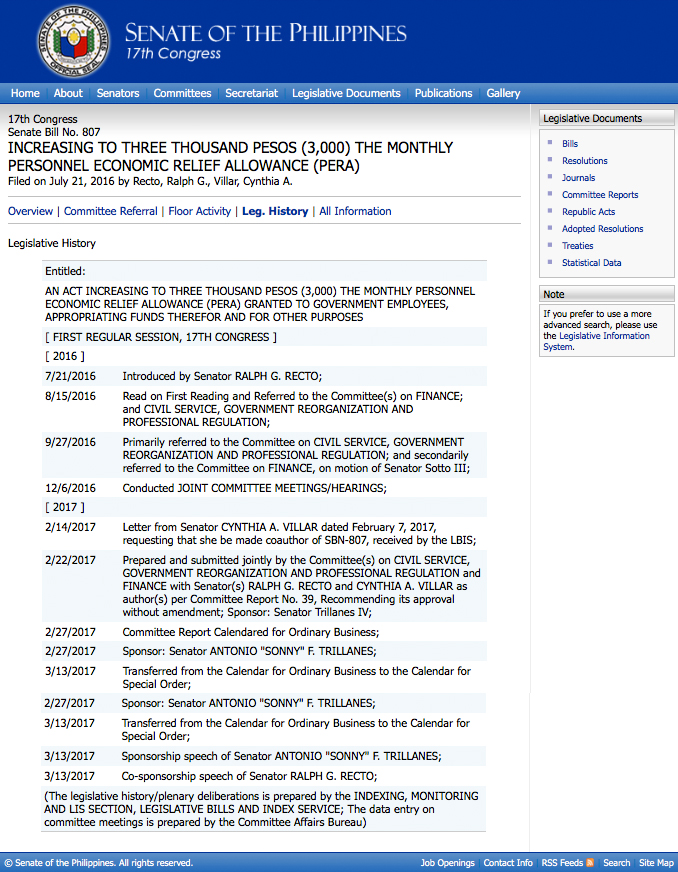‘Why It Is Hard and Heartless to Veto a P3,000 PERA for Public Workers’
One item in the government employee payslip turns 26 this year.
In June 1991, pursuant to that year’s General Appropriations Act, a Personnel Economic Relief Allowance in the amount of P500 a month was granted to all government employees.
Two years later, an “Additional Compensation” or “AdCom” of P500 per month was added when President Ramos issued Administrative Order 53 in 1993.
In 2006, President Arroyo raised the AdCom to P1,500 a month.
Three years later, under Joint Resolution No. 4 of Congress, the P1,500-AdCom was merged with the P500-PERA, with the latter as the surviving nomenclature.
In the eight years that PERA has been nailed at P2,000, rice prices have soared by 21.8 percent, and the peso had lost 26.7 percent of its value to inflation.
Thus, this bill seeks to recover the erosion in PERA’s worth, by increasing it to P3,000.
Admittedly, the P1,000 increase will not allow government workers to get rich, not even to fully get by.
But if reckoned annually, the P12,000 increase will help pay certain bills, like a semester’s tuition in an SUC, or six sacks of rice, or for a small family, probably a year’s water bills plus cable TV subscription.
Although a P1,000 increase may not be enough, the financing it requires is enormous.
The present P2,000 PERA costs taxpayers P33 billion a year. Raising it to P3,000 would require P16.5 billion.
Taken against the big Personal Services or PS picture of the government, the P33 billion is 3 percent of the almost P1 trillion PS outlay this year.
It would have been scandalous if the proposed PERA increase is the sole pay amelioration initiative in the public sector since 2006.
But in the 12 years since, there have been pay or across-the-board allowance increases in eight of those years.
In 2006, the P1,000 AdCom was granted.
In 2007, a 10-percent increase in the basic monthly salaries of civilian government personnel. Also that year, the subsistence allowance of uniformed personnel was increased by P30 a day. Their hazard pay was also increased.
In 2008 came the 10-percent across-the-board increase in basic monthly salaries of government personnel. This was followed by four annual installments of the SSL 3 from 2009 to 2012.
The SSL 4, to be given in “four gives”, commenced last year. By 2019, there would have been 10 annual government pay increases in the past 14 years.
Not only that, there were also upward adjustments in the special allowances of certain government employees in some of those years.
To cite an example, the P60 increase in the daily subsistence allowance of uniformed personnel authorized by Joint Resolution No. 2 in 2015, which was authored by Senator Sonny Trillanes.
Another is the increase, through an executive fiat, in the “actual combat pay” of soldiers and policemen last year. This is EO 3 issued by President Duterte on September 1, 2016.
There are reports that some qualified personnel have yet to get theirs. If true, it is hoped that these outstanding payables will be settled soon, especially if owed to brave men who are in the line of fire.
In the light of these increases, this bill seeks to lift the embargo on PERA adjustment, but at a level government finances can afford.
It is borne out of the stark realization that many urgent needs of our people compete for scarce resources, like health and education and irrigation and roads, all of which require amelioration as well.
Pegging an increase that is not too big to fund effectively denies the executive branch of any excuse to veto a very reasonable measure.
While it will add a little amount in the employee’s pocket, it won’t burn a hole in the government’s. Thus, it will be hard, if not heartless, to reject a bill such as this.

RELATED ARTICLES:
-
14 MAR 2017: Recto sponsors P3,000 ‘PERA’ for gov’t employees
-
01 JUL 2016: Recto: Additional PERA now, SSL IV later

